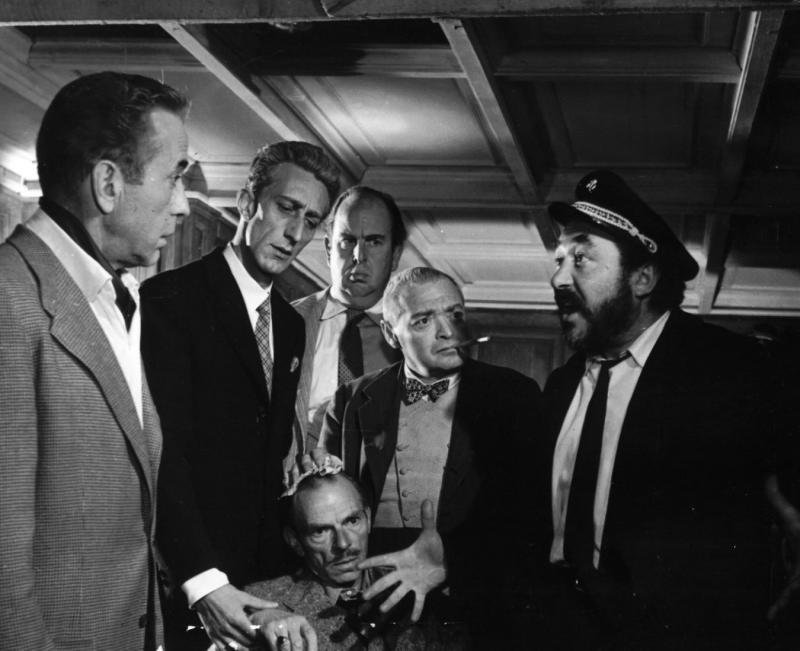Beat the Devil (1953) Review
Humphrey Bogart and the troupe of charlatans in John Huston’s Beat the Devil (1953)
It’s hard to define John Huston’s Beat the Devil (1953). The viewer will first think, “What is going on here?”; then, “Strange, really strange, I know not where to land my feet”; eventually, “What the hell! Just go along with it, it’s total madness”. It’s an adventure, sure, but a quaint one at that. And it’s a comedy, definitely, but not outspoken. We’re only convinced of it being a comedy midway in our journey. It’s a parody of Huston’s The Maltese Falcon (we even have both Humphrey Bogart and Peter Lorre on screen); it’s also a spoof on a certain genre, the international spy-caper thriller. Pauline Kael pointed out that, as a satire, the film resembles Robert Altman’s The Long Goodbye (1973) (or, rather, The Long Goodbye resembles it). It’s, then, the hilarious undoing of a genre. Some say it’s the first camp film...
It’s all of these things and irreducible to them all, for Beat the Devil has no pretense at being anything. It’s consciously frivolous. The best way to inadequately described it, then, is as a rogue movie. Unlike most of contemporary Hollywood, it’s not a well-crafted engine of emotional stimuli; it’s not obsessed with visual effects or stunts, nor with historical "accuracy"; it’s not “based on a real story”, nor does it care for “urgent” moral and political issues. And it does not fit in Old Hollywood as well; nor does it prefigure New Hollywood’s psychological realism (far from that). Beat the Devil takes artistic pretension and rolls a cigarette with it– then burns down the house. A bunch of talented people get together on the Mediterranean coast and fool around with shooting a picture. That’s it.
A fine tale of charlatans, which unfortunately gives in to some sentimentality, Beat the Devil is wry and tough, but also silly and clumsy. The film that is most similar to it is Mario Monicelli’s Big Deal on Madonna Street (https://www.thefilmocrat.com/reviews/big-deal-on-madonna-street-1958-review).
But here we have a surplus of Hollywood panache. John Huston and Truman Capote (the fellow screenwriter) did not actually know what they were doing, but had lots of confidence. Capote kidded around with the writing, letting actors pen their own lines at times; Huston improvised and played the rascal with directing, coming up with things in the process. The audience feels it: spontaneous foolishness becomes a most welcoming companion throughout the film.
Bogart as Billy Dannreuther is great as usual, the film’s lighthearted, and typically cynical, center of gravity. The band of rogues belongs to the ages: the fatso (Robert Morley), the vampire (Marco Tulli), the sleazy shorty (Peter Lorre), the mustached Nazi (Ivor Barnard). Caricatures of international criminals. As Roger Ebert says in his review: “They were born looking guilty” (https://www.rogerebert.com/reviews/great-movie-beat-the-devil-1954).
A rogue movie. Both women – Bogart’s wife (Gina Lollobrigida) and, mainly, Gwendolen (Jennifer Jones) – play the romantic escapists, delusional, bovarists, with a tinge of mischievous deceit. In one of the best lines in the film, Gwendolen warns her husband on the dangers of such a gang: “They’re desperate characters. Not one of them looked at my legs.”
The plot doesn’t matter. It’s all about character, mise-en-scène, turns of phrase. At one moment, the mustached nazi thinks the fatso, Petersen, has died. He laments the falling of great men: “Mussolini, Hitler–– and now, Petersen!”
There’s a scene where Bogart, his fat crook of a driver, and the fatso step out to push an old car down the road. The car takes speed, they can’t go back inside and watch like three idiots as it goes off a cliff. This has a Marx Brothers quality to it; the very moment the film becomes nonsense. After that we get the idea: nobody takes anything seriously. The viewer ought not to take it seriously also. It’s a liberating and counterintuitive experience in cinema.
Huston likely regrets not going full-rogue, allowing some mellowness, but he got close, pretty close. The Maltese Falcon gone blithely awry. And the surprise is: it makes for an even better picture precisely for this.


